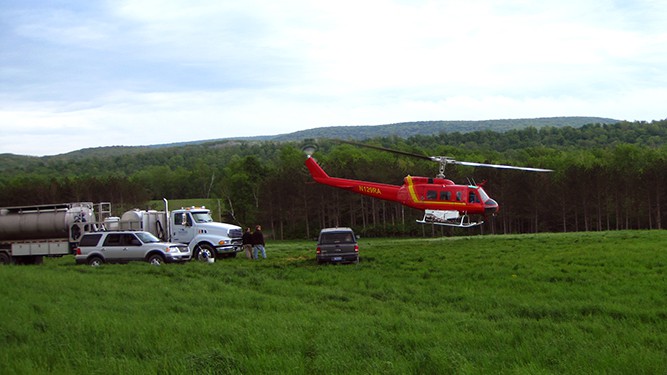Many residents of Pennsylvania are likely aware of the damage spongy moth can do to our forested ecosystems, even if they are now scratching their heads and saying, “What in the world is a spongy moth?”
Spongy moth is the new name decided by the Entomological Society of America for the gypsy moth (Lymantria dispar dispar).
This invasive moth species was introduced from Eurasia in 1869; and has been causing significant forest damage in Pennsylvania since the 1970s.
Although many tree and shrub species are targeted, oak species are spongy moth’s preferred food source.
Boom and bust cycles in spongy moth can lead to defoliation, weakening trees, or killing them outright after repeated defoliation.
And unfortunately, parts of the Commonwealth are currently in the midst of a boom cycle, with heavy egg mass counts in the central portions of the state.
While DCNR’s Bureau of Forestry, Game Commission, and some other large landowners are able to treat some of the worst areas to mitigate the impacts of spongy moth, resources for treatment are limited.
Treating Public Lands for 2023 Spongy Moth Outbreak

DCNR spongy moth aerial spraying
DCNR is aiming to treat roughly 300,000 acres in 2023, using applications of Bacillus thuringiensis, subspecies kurstaki (Btk) -- a natural biological insecticide and tebufenozide -- an insect growth regulator -- via aerial application using airplanes and helicopters.
This is one of the largest planned treatments for spongy moth in terms of acres treated in DCNR’s history.
These treatments focus on areas with high egg mass density trending upward and favorable tree species (from the spongy moth’s perspective); and take into account a variety of ecological concerns.
Unfortunately, even 300,000 acres worth of treatment still leaves many areas without protection.
So, Pennsylvanians should be prepared for seeing another bad year of defoliation in some areas -- large portions of brown, dead tree canopy among our green mountain ranges this summer. So, is there anything private landowners can do?
Spongy Moth Tips for Private Landowners
Experts say that private landowners should consider the possibility that their woods could be heavily impacted by spongy moth.
First, does the property contain species favored by the spongy moth?
For a list of preferred spongy moth food species, see DCNR’s Guide to Conducting a Private Lymantria dispar dispar (Spongy Moth) Suppression Program (PDF).

Spongy moths surrounded by egg masses
If preferred trees are present in significant numbers, then landowners should survey their forested areas for egg masses in the late summer and fall.
Penn State Extension provides a helpful guide for identifying spongy moth egg masses and calculating egg mass density.
Once egg mass density has been calculated, the need for treatment, as well as potential methods, can be considered.
Lower levels of egg masses (250-400 egg masses per acre) often do not cause significant damage to woodlands.
Management is recommended for higher egg mass densities, which can lead to heavy defoliation or even tree mortality.
For individual landscape trees, mechanical removal is an option.
However, for larger areas, chemical treatments are significantly more cost effective.
DCNR does not conduct spray programs for spongy moth on private lands. The department does recommend that large landowners, counties, or municipalities band together to create a private spray program.
By combining acreage and appointing a project coordinator, such spray programs can contract treatment from existing aerial applicators who can help determine the need for treatment, insecticide use, and timing of treatment.
DCNR maintains a list of aerial applicators (PDF) that can be contracted for treatments.
Private landowners need to start to make plans for a treatment in the fall and winter preceding what is generally a May treatment window.
If you see a lot of defoliation in your area and are concerned about the tree mortality that multiple years of spongy moth outbreak may cause, you should look into conducting egg mass surveys and treatment options well before May 2024.